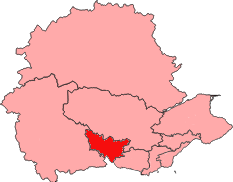|
Ashfield, Stirling
Ashfield () is a small village in the Registration county of Perth and the local government district of Stirling, Scotland. It lies between the Allan Water and the Stirling-Perth Railway line. It is two miles north of Dunblane Dunblane (, ) is a town in the council area of Stirling in central Scotland, and inside the historic boundaries of the county of Perthshire. It is a commuter town, with many residents making use of good transport links to much of the Central Be ..., and was designated a conservation village in 1976. It was originally built to house workers at a nearby silk-dyeing mill. Prior to this, a mill, Millash or Mill of Ash, existed, as did an extensive house or farm. Ashfield has four residential streets (Ochilview, Allanview, The Steading and The Cottages), a residential block (The Clachan) and also a square, named after the former prime minister William Gladstone, called Gladstone Square. There are various annual activities based in the village hall such as a ... [...More Info...] [...Related Items...] OR: [Wikipedia] [Google] [Baidu] |
Dunblane
Dunblane (, ) is a town in the council area of Stirling in central Scotland, and inside the historic boundaries of the county of Perthshire. It is a commuter town, with many residents making use of good transport links to much of the Central Belt, including Glasgow and Edinburgh. Dunblane is built on the banks of the Allan Water (or River Allan), a tributary of the River Forth. Dunblane Cathedral is its most prominent landmark. Dunblane had a population of 8,114 at the 2001 census, which grew to 8,811 at the 2011 census; both of these figures were computed according to the 2010 definition of the locality. In mid-2016 it was estimated that the population had grown to 9,410. Origin of name The most popular theory for the derivation of the name "Dunblane" is that it means "fort of Blane", commemorating Saint Blane (or Blán in Old Irish), an early Christian saint who lived probably in the late 6th century. His main seat was originally Kingarth on the Isle of Bute. He or hi ... [...More Info...] [...Related Items...] OR: [Wikipedia] [Google] [Baidu] |
Lecropt
Lecropt (''Leac Croit'' in Gaelic) is a rural parish lying to the west of Bridge of Allan, Scotland. The population of the parish of Lecropt is estimated to be around 75, consisting entirely of isolated farms and houses, as well as the Keir Estate owned by the landed Stirling family. Lecropt today contains no town or village, though it lies on the outskirts of the village of Bridge of Allan. Historically, Lecropt's population was higher and was as high as 500 around the year 1800. The decline in population over the decades can be explained partly, but not wholly, by rural depopulation. However, in 1800 Bridge of Allan, then a tiny hamlet of no more than 100 people, was included in Lecropt. As Bridge of Allan grew during the 19th century, the whole village was eventually brought under the adjacent parish of Logie, reducing Lecropt's population. There had also been another village called Lecropt, the site of which was further north-west, on the other side of the line of the M9 ... [...More Info...] [...Related Items...] OR: [Wikipedia] [Google] [Baidu] |
Stirling And Falkirk
Stirling and Falkirk is a lieutenancy area of Scotland. It consists of the local government areas of Stirling and Falkirk Falkirk ( ; ; ) is a town in the Central Lowlands of Scotland, historically within the county of Stirlingshire. It lies in the Forth Valley, northwest of Edinburgh and northeast of Glasgow. Falkirk had a resident population of 32,422 at the ..., which cover the same areas as the previous districts from 1975 to 1996. References The Lord-Lieutenants (Scotland) Order 1996, Statutory Instrument 1996 No. 731 (S.83). Lieutenancy areas of Scotland Falkirk (council area) Stirling (council area) {{Scotland-gov-stub ... [...More Info...] [...Related Items...] OR: [Wikipedia] [Google] [Baidu] |
Stirling (UK Parliament Constituency)
Stirling (; ; ) is a city in central Scotland, northeast of Glasgow and north-west of Edinburgh. The market town, surrounded by rich farmland, grew up connecting the royal citadel, the medieval old town with its merchants and tradesmen, the Old Bridge and the port. Located on the River Forth, Stirling is the administrative centre for the Stirling council area, and is traditionally the county town and historic county of Stirlingshire. Stirling's key position as the lowest bridging point of the River Forth before it broadens towards the Firth of Forth made it a focal point for travel north or south. It has been said that "Stirling, like a huge brooch clasps Highlands and Lowlands together". The city's status as "Gateway to the Highlands" also historically lent it great strategic importance—the credo "he who holds Stirling, holds Scotland" is sometimes attributed to Robert the Bruce. When Stirling was temporarily under Anglo-Saxon sway, according to a 9th-century legend ... [...More Info...] [...Related Items...] OR: [Wikipedia] [Google] [Baidu] |
Clackmannanshire And Dunblane (Scottish Parliament Constituency)
Clackmannanshire and Dunblane ( Gaelic: ''Siorrachd Chlach Mhanann agus Dùn Bhlàthain'') is a constituency of the Scottish Parliament ( Holyrood) covering part of the Stirling council area and the entirety of Clackmannanshire. It elects one Member of the Scottish Parliament (MSP) by the plurality (first past the post) method of election. It is one of nine constituencies in the Mid Scotland and Fife electoral region, which elects seven additional members, in addition to the nine constituency MSPs, to produce a form of proportional representation for the region as a whole. Created in 2011, the constituency covers much of the area previously in the abolished Ochil constituency. The seat has been held by Keith Brown of the Scottish National Party since its creation; Brown was previously the MSP for the preceding constituency of Ochil. Electoral region The other eight constituencies of the Mid Scotland and Fife region are: Cowdenbeath, Dunfermline, Kirkcaldy, Mid Fife a ... [...More Info...] [...Related Items...] OR: [Wikipedia] [Google] [Baidu] |
Stirling (council Area)
The Stirling council area (; ) is one of the 32 council areas of Scotland, and has an estimated population of (). It was created in 1975 as a lower-tier districts of Scotland, district within the Central Region, Scotland, Central Regions and districts of Scotland, region. The district covered parts of the Shires of Scotland, historic counties of Stirlingshire and Perthshire, which were abolished for local government purposes. In 1996 the Central region was abolished and Stirling Council took over all local government functions within the area. The administrative centre of the area is the city of Stirling, with the headquarters at Old Viewforth. The area borders the council areas of Clackmannanshire (to the east), North Lanarkshire (to the south), Falkirk (council area), Falkirk (to the south east), Perth and Kinross (to the north and north east), Argyll and Bute (to the north and north west), and both East Dunbartonshire, East and West Dunbartonshire to Stirling's southwest. ... [...More Info...] [...Related Items...] OR: [Wikipedia] [Google] [Baidu] |
Registration County
A registration county was, in Great Britain and Ireland, a statistical unit used for the registration of births, deaths and marriages and for the output of census information. In Scotland registration counties are used for land registration purposes. England and Wales The Births and Deaths Registration Act 1836 divided England and Wales into registration districts. The districts were not innovations, however, but were identical to the poor law unions already in existence. Unions had been formed by the grouping parishes surrounding towns in which a workhouse was situated without reference to geographical county boundaries. Many PLUs included areas in two or more civil counties. Registration counties (also known as poor law counties) were formed by the aggregation of registration districts by reference to which county the workhouse was situated in. Accordingly, the boundaries of registration counties rarely coincided with those of the civil county. Attempts to establish a single s ... [...More Info...] [...Related Items...] OR: [Wikipedia] [Google] [Baidu] |
Stirling (district)
The Stirling council area (; ) is one of the 32 council areas of Scotland, and has an estimated population of (). It was created in 1975 as a lower-tier district within the Central region. The district covered parts of the historic counties of Stirlingshire and Perthshire, which were abolished for local government purposes. In 1996 the Central region was abolished and Stirling Council took over all local government functions within the area. The administrative centre of the area is the city of Stirling, with the headquarters at Old Viewforth. The area borders the council areas of Clackmannanshire (to the east), North Lanarkshire (to the south), Falkirk (to the south east), Perth and Kinross (to the north and north east), Argyll and Bute (to the north and north west), and both East and West Dunbartonshire to Stirling's southwest. The majority of the population of the area is located in its southeast corner, in the city of Stirling and in the surrounding lowland communities: ... [...More Info...] [...Related Items...] OR: [Wikipedia] [Google] [Baidu] |
Allan Water
The Allan Water () is a river in central Scotland. Rising in the Ochil Hills, it runs through Strathallan to Dunblane and Bridge of Allan before joining the River Forth. It is liable to cause floods in lower Bridge of Allan. It shares its name with a tributary of the River Teviot. The name is similar to the Ale Water in Berwickshire, the River Alness in Ross-shire, the Allander Water in Stirlingshire, the River Alne and the Ayle Burn in Northumberland, the River Ellen in Cumbria, and several names in the south of England, Wales and Cornwall. Ptolemy, who wrote his Geography about 150 AD, gave the names of some of these rivers as Alauna or Alaunos. Ekwall says that Alauna or Alaunos are British .e. Brythonic or P-Celticriver names. Nicolaisen says that the name Allan is of Pre-Celtic Indo-European origin. Its original form was Alauna, from the Indo-European root *el-/ol-, meaning "to flow, to stream". Several European rivers and settlements have names that may come from tha ... [...More Info...] [...Related Items...] OR: [Wikipedia] [Google] [Baidu] |


